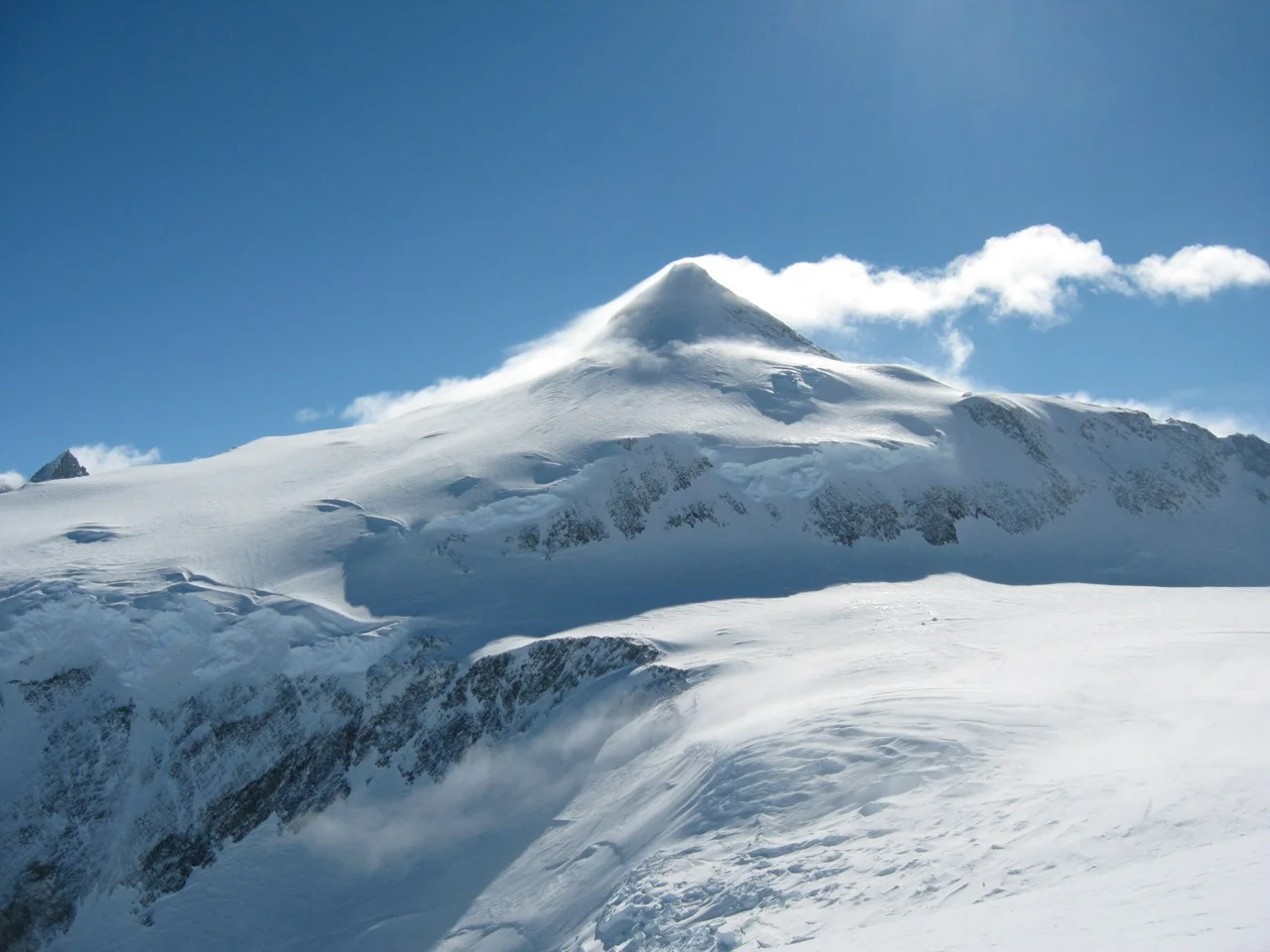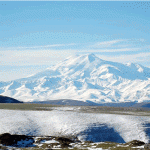The Seven Summits are the highest mountains on each of the seven continents on our planet. These seven summits represent the premier challenge for mountain climbers. Wendy shares in her book the interesting turn of events after she ran the Boston Marathon that took her first to Denali, which she would later find out was actually McKinley.
Wendy found a passion in climbing after that trip, and decided to go all in and climb the Seven Summits. One thing is certain: she never looked back. Here are the Seven Summits (listed in chronological order of her journey).
1. Mt. McKinley (Denali, Alaska, USA)
- Elevation (feet): 20,320
- Range: Alaska/Yukon Ranges
- Country: United States
- Continent: North America
- Difficulty: Major Mountain Expedition
- Year first climbed: 1913
- Wendy reached the summit on June 27, 2004
Mount McKinley is the highest peak in North America. It is a huge snowy mass, flanked by five giant glaciers and countless icefalls. Its steep unbroken south slope rises 17,000 feet in twelve miles. Five major ridges extend from the summit, and many spurs and buttresses extend from these. The mountain is increasingly known by its native name, Denali, which means “The Great One” in the Athabaskan language. Denali is not an especially difficult climb technically, but the weather is more severe here than anywhere else in the world, and many lives have been lost attempting the ascent.
2. Mt. Kilimanjaro (Africa)
- Elevation (feet): 19,563
- Range: East Africa Mountains
- Country: Tanzania
- Continent: Africa
- Difficulty: Walk up
- Year first climbed: 1889
- Wendy reached the summit on June 20, 2005
Kilimanjaro is the highest mountain in Africa, located in Northeast Tanzania, near the Kenya border. Kilimanjaro is an extinct volcano, and is one of the most massive in the world. Kilimanjaro’s summit crater, known as Kibo, measures an incredible 1.5 miles across. The approach and climb provides spectacular diversity, from scrub-lands thick with African wildlife to lush forests to flowering alpine tundra. All this finally gives way to snow and rock above 15,000 feet.
3. Mt. Elbrus (Russia)
- Elevation (feet): 18,510
- Range: Caucasus Mountains
- Country: Russia
- Continent: Europe
- Difficulty: Basic Snow/Ice Climb
- Year first climbed: 1874
- Wendy reached the summit on July 27, 2006
Mount Elbrus is the highest peak in Europe. It is part of the Central Caucasus, but is located several miles north of the main crest. Its origin is volcanic, and though it has long been extinct, it still retains its gently sloping, conical shape. The summit is capped in ice year round, and countless glaciers sprawl from its slopes. The summit provides incredible views of the entire Caucasus.
4. Mt. Aconcagua (Argentina)
- Elevation (feet): 22,841
- Range: Andes
- Country: Argentina
- Continent: South America
- Difficulty: Major Mountain Expedition
- Year first climbed: 1897
- Wendy reached the summit on January 9, 2007
Aconcagua is the highest mountain in the Western hemisphere, located in western Argentina, near the Chile border. It dominates the sky west of Santiago, Chile’s capital city, and is visible from the Pacific coast, 100 miles away. Though the mountain’s summit crest and radiating ridges are largely windswept free of snow, large glaciers fill the valleys on all but the southern and western flanks. Some climbing routes are relatively straightforward hikes to the top, but this is the very reason that Aconcagua has one of the highest mountain death tolls in the world: many of its climbers tend to move too swiftly up the mountain, with little respect for the elevation or the weather.
5. Mt. Vinson Massif (Antarctica)
- Elevation (feet): 16,067
- Range: West Antarctica Ranges
- Country: Antarctica
- Continent: Antarctica
- Difficulty: Major Mountain Expedition
- Year first climbed: 1966
- Wendy reached the summit on January 8, 2008
Vinson Massif is the highest mountain of Antarctica. It is a massive mountain, stretching thirteen miles long and eight miles wide. Its location, the Sentinel Range of the Ellsworth Mountains, is home to most of Antarctica’s highest peaks. Climbing Vinson is not considered technically difficult, but Antarctica’s extreme climate makes ascending Vinson a serious undertaking.
6. Mt. Kosciuszko (Australia)
- Elevation (feet): 7,310
- Range: Snowy Mountains
- Country: Australia
- Continent: Australia/Oceania
- Difficulty: Scramble
- Year first climbed: 1840
- Wendy reached the summit November 21, 2008
Mt. Kosciuszko is the highest peak in Australia, and though not large by mountaineering standards, it is one of the oldest in the world. Some 30,000 people make the trek to the summit of Kosciuszko each year, either hiking in the summer or skiing in the winter. There is some dispute over whether Puncak Jaya (the Carstensz Pyramid in Papua New Guinea) is the highest peak on the seventh continent due to its title as the highest mountain in the Pacific Basin, but Mt. Kosciuszko is generally considered to be the “seventh summit” at this time.
7. Mt. Everest ( Asia)
- Elevation (feet): 29,035
- Range: Himalaya
- Country: Nepal
- Continent: Asia
- Difficulty: Major Mountain Expedition
- Year first climbed: 1953
- Everest has come to be the biggest challenge for Wendy. She attempted to reach the summit twice – in April of 2009 and again in April 2010. Reaching 22, 300 feet above sea level, Wendy’s MS began to flare up. She was strongly advised to descend the mountain, and after much pain came to the point where the altitude was just too unsafe for her climbing to continue. Everest remains the last of the seven summits for Wendy…
Mount Everest is the highest mountain in the world. Its elevation of 29,035 feet (8,850 meters) was determined using GPS satellite equipment on May 5, 1999.
The first seven attempts on Everest, starting with a reconnaissance in 1921, approached the mountain from Tibet, where a route to the summit via the North Col and North Ridge seemed possible. All were unsuccessful. George Mallory, who spearheaded the first three expeditions, lost his life with Andrew Irvine during a failed ascent in 1924.
Unsuccessful attempts continued through 1938, then halted during World War II. By the war’s end, Tibet had closed its borders, and Nepal, previously inaccessible, had done the opposite.
Starting in 1951, expeditions from Nepal grew closer and closer to the summit, via the Khumbu Icefall, the Western Cwm, over the Geneva Spur to the South Col, and up the Southeast Ridge. In 1953 Edmund Hillary and Tenzing Norgay reached the summit. Since the first successful ascent, many other individuals have sought to be the first at various other accomplishments on Everest, including many alternative routes on both the north and south sides.
Italy ‘s Reinhold Messner has climbed Everest twice without oxygen, once in four days. He is also the first to solo climb Everest, which he did in 1980. Ten years earlier, Yuichiro Miura of Japan had been the first person to descend the mountain on skis. In 1975, Junko Tabei, also of Japan, was the first woman to climb Everest. The first disabled person to attempt Everest was American Tom Whittaker, who climbed with a prosthetic leg to 24,000 feet in 1989, 28,000 feet in 1995, and finally reached the summit in 1998. The first blind man to reach the summit was Erik Weihenmayer in 2001. The record for most ascents belongs to Sherpa Ang Rita, who has reached the summit ten times.
Overall, more than 600 climbers from 20 countries have climbed to the summit by various routes from both north and south. Climbers’ ages have ranged from nineteen years to sixty. At least 100 people have perished, most commonly by avalanches, falls in crevasses, cold, or the effects of thin air.
Climbing on Everest is strictly regulated by both the Nepalese and Chinese governments. Permits cost thousands of U.S. dollars and are difficult to obtain. Total expedition costs are often in excess of $200,000 and US. Waiting lists extend for years. Treks to Everest base camp, minus the summit attempt, are becoming increasingly popular on both the north and south sides of the mountain. On the north side, a Buddhist monastery stands at the foot of the Rongbuk Glacier, beneath Everest’s spectacular north face. The monastery is one of two whose locations were selected specifically to allow religious contemplation of the great peak. The other is the Thyangboche Monastery in Nepal. The once-active Rongbuk monastery in Tibet has required much rejuvenation from the destruction it experienced following China’s invasion of Tibet.
Mount Everest is also known by the Tibetan name Chomolangma (Goddess Mother of the Snows), and by the Nepali name Sagarmatha (Mother of the Universe).








